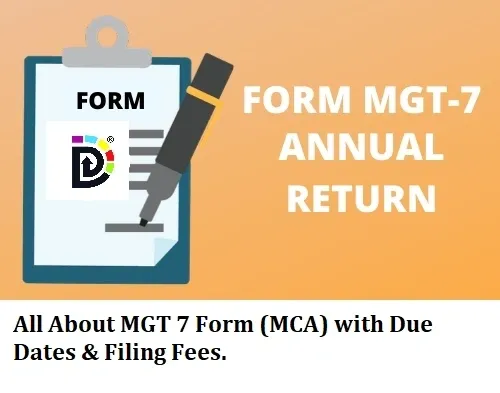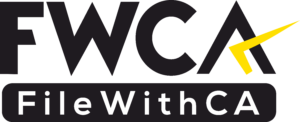Comprehensive Guide to MCA Form MGT-7: Due Dates, Filing Fees, and Detailed Filing Process

As a pivotal component of corporate compliance in India, the MGT-7 Form serves as the annual return that companies must file with the Ministry of Corporate Affairs (MCA). This document encapsulates a company’s financial health, operational activities, and structural details, ensuring transparency and adherence to regulatory standards. This guide provides an in-depth exploration of Form MGT-7, covering its purpose, detailed filing process, due dates, associated fees, and the consequences of non-compliance.
Understanding Form MGT-7
Contents
- Understanding Form MGT-7
- Who Is Required to File Form MGT-7?
- Due Dates for Filing Form MGT-7
- Filing Fees for Form MGT-7
- Detailed Filing Process for Form MGT-7
- Penalties for Late Filing or Non-Compliance
- Key Benefits of Filing Form MGT-7
- Common Mistakes to Avoid
- Tips for Seamless Filing
- Recent Updates on Form MGT-7 (2024)
- Conclusion
Form MGT-7 is the prescribed format for filing a company’s annual return under the Companies Act, 2013. It captures comprehensive information about the company as of the financial year’s end, including:
- Corporate Information: Details such as the Corporate Identification Number (CIN), company name, registered office address, and date of incorporation.
- Principal Business Activities: A breakdown of the company’s main business activities, including their contribution to the company’s turnover.
- Shareholding Pattern: Information on the company’s share capital structure, including details of shareholders and changes during the year.
- Directors and Key Managerial Personnel: Details of directors and key managerial personnel, along with any changes during the financial year.
- Meetings: Records of meetings held during the year, including board meetings and general meetings, along with attendance details.
- Remuneration: Information on the remuneration of directors and key managerial personnel.
- Penalties and Punishments: Details of any penalties or punishments imposed on the company, its directors, or officers, and information on compounding of offences.
The primary objective of Form MGT-7 is to ensure that the company’s stakeholders, including regulatory authorities, have access to accurate and up-to-date information about the company’s operations and compliance status.
Who Is Required to File Form MGT-7?
Every company incorporated under the Companies Act, 2013, or any previous company law, is mandated to file Form MGT-7. This includes:
- Public Companies: Companies that have issued securities through an initial public offering (IPO) and are listed on stock exchanges.
- Private Companies: Companies that are privately held and have not issued shares to the general public.
- One Person Companies (OPCs) and Small Companies: These entities are required to file a simplified annual return using Form MGT-7A.
It’s important to note that while OPCs and small companies have a different form (MGT-7A), the due dates and filing requirements are similar to those of other companies.
Due Dates for Filing Form MGT-7
The due date for filing Form MGT-7 is linked to the date of the company’s Annual General Meeting (AGM). According to the Companies Act, 2013:
- AGM Deadline: Companies are required to hold their AGM within six months from the end of the financial year, i.e., by 30th September each year.
- Filing Deadline: Form MGT-7 must be filed within 60 days from the date of the AGM.
For example, for the financial year ending on 31st March 2024:
- AGM Date: On or before 30th September 2024.
- MGT-7 Filing Due Date: Within 60 days from the AGM date, i.e., by 29th November 2024.
It’s crucial for companies to adhere to these timelines to avoid penalties and ensure compliance with statutory requirements.
Filing Fees for Form MGT-7
The filing fee for Form MGT-7 is determined based on the company’s authorized share capital. The fee structure is as follows:
- Authorized Share Capital up to ₹1,00,000: ₹200 per document.
- Authorized Share Capital between ₹1,00,000 and ₹4,99,999: ₹300 per document.
- Authorized Share Capital between ₹5,00,000 and ₹24,99,999: ₹400 per document.
- Authorized Share Capital between ₹25,00,000 and ₹99,99,999: ₹500 per document.
- Authorized Share Capital ₹1,00,00,000 or more: ₹600 per document.
For companies not having a share capital, the fee is ₹200 per document.
It’s important to ensure that the correct fee is paid at the time of filing to prevent any delays or rejections of the form.
Detailed Filing Process for Form MGT-7
Filing Form MGT-7 involves several steps to ensure accurate and complete submission. Below is a step-by-step guide to the filing process:
1. Preparation of Information
Before initiating the filing process, gather all necessary information and documents, including:
- Corporate Details: CIN, company name, registered office address, and date of incorporation.
- Principal Business Activities: Descriptions and corresponding codes of main business activities, along with their percentage contribution to turnover.
- Shareholding Pattern: Details of equity and preference share capital, including the number of shares, nominal value, and paid-up value.
- Directors and Key Managerial Personnel: Names, DINs, positions, and dates of appointment or cessation.
- Meetings: Dates of board meetings, committee meetings, and general meetings, along with attendance records.
- Remuneration: Details of remuneration paid to directors and key managerial personnel.
- Penalties and Punishments: Information on any penalties or punishments imposed during the financial year.
Having this information readily available will facilitate a smooth filing process.
2. Accessing the Form
- Download the latest version of Form MGT-7 from the Ministry of Corporate Affairs (MCA) website (www.mca.gov.in).
- Ensure that your system has the latest version of Java Runtime Environment (JRE) installed, as the MCA portal often requires it to access and fill forms.
3. Filling the Form
Step 1: Company Information
- Enter the CIN of the company. Use the MCA’s Find CIN tool if you’re unsure about the number.
- The form will auto-populate basic company details like the name, registered office address, and email ID.
- Verify all pre-filled information for accuracy.
Step 2: Principal Business Activities
- Select the Main Division of Business from the provided list.
- Specify the percentage contribution of each activity to the total turnover of the company.
- Fill in the details of authorized, issued, and paid-up capital.
- Provide the number of shares at the beginning and end of the financial year.
- Update details of shareholders and any changes in shareholding patterns during the year.
Step 4: Directors and Key Managerial Personnel (KMP)
- List all directors and KMPs, including their:
- Director Identification Numbers (DINs)
- Positions (e.g., Managing Director, CFO)
- Dates of appointment or cessation.
Step 5: Meetings
- Record the number and dates of:
- Board Meetings
- General Meetings
- Committee Meetings (if applicable)
- Include attendance details for each meeting.
Step 6: Penalties and Punishments
- Declare any penalties, fines, or legal actions imposed on the company or its officers during the financial year.
Step 7: Certification
- The form must be certified by:
- A practicing Company Secretary (CS), or
- A Chartered Accountant (CA) in whole-time practice (for private companies with limited scope).
4. Uploading and Filing
Step 1: Generating SRN
- After completing and saving the form, log in to the MCA portal with your credentials.
- Upload the form and generate a Service Request Number (SRN) for tracking.
Step 2: Fee Payment
- Pay the applicable fees online via net banking, credit card, or other approved methods.
- Download the payment receipt for future reference.
Step 3: Submission
- Once payment is complete, submit the form on the MCA portal.
- Download the Acknowledgment Receipt as proof of filing.
Penalties for Late Filing or Non-Compliance
Timely filing of Form MGT-7 is crucial to avoid penalties. The consequences of non-compliance include:
- Late Filing Fee
- ₹100 per day of delay, with no upper limit on the total fee.
- Additional Penalties
- Companies may face penalties under Section 92(5) of the Companies Act, 2013:
- Fine for the company: ₹50,000 to ₹5,00,000.
- Fine for officers in default: ₹50,000, plus ₹100 per day of default.
- Companies may face penalties under Section 92(5) of the Companies Act, 2013:
- Legal Consequences
- Persistent non-compliance may result in prosecution under corporate laws.
Key Benefits of Filing Form MGT-7
- Transparency:
- Provides shareholders and stakeholders with a clear view of the company’s performance and compliance status.
- Legal Compliance:
- Demonstrates adherence to corporate laws, avoiding legal penalties and reputational damage.
- Financial Insights:
- Helps in analyzing the company’s financial health, shareholder changes, and operational structure.
- Ease of Business:
- Timely filing ensures smoother audits and facilitates easier access to loans, funding, or partnerships.
Common Mistakes to Avoid
- Incorrect Details:
- Ensure all information matches the company’s records, such as share capital and shareholder names.
- Missed Deadlines:
- Set reminders for filing deadlines to avoid penalties.
- Non-Verification by Professionals:
- Always have the form reviewed and certified by a practicing CS or CA.
- Payment Errors:
- Confirm the fee structure and double-check payment details to avoid delays.
Tips for Seamless Filing
- Prepare Early:
- Start gathering necessary information and documents as soon as the financial year ends.
- Use Technology:
- Invest in reliable accounting and compliance software to track data throughout the year.
- Stay Updated:
- Regularly check MCA notifications for updates on deadlines or procedural changes.
- Consult Professionals:
- Work with an experienced CS or CA to ensure accuracy and compliance.
Recent Updates on Form MGT-7 (2024)
- Digitization Push:
- MCA has introduced enhanced digital filing systems for easier and more efficient submissions.
- Extended Filing Deadlines:
- For 2024, companies affected by regulatory changes may receive a grace period for compliance.
- Increased Penalties:
- MCA has emphasized stricter enforcement, with higher penalties for persistent non-compliance.
Conclusion
Filing Form MGT-7 is an integral part of corporate compliance, reflecting a company’s commitment to transparency and legal adherence. By understanding its requirements, following the prescribed steps, and meeting deadlines, companies can avoid penalties and maintain good standing with regulatory authorities.
Staying proactive, leveraging technology, and consulting professionals can simplify the process, ensuring your annual return is accurate and timely. Make compliance a priority—your business’s reputation depends on it.





